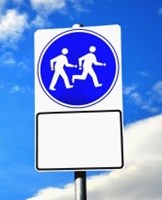
While much attention is always paid to common issues on the road, such as hikes in fuel prices and the state of road infrastructure, less emphasis is being placed on other equally important issues, particularly pertaining to the safety of those without vehicles namely the pedestrians.
Studies have identified that pedestrian injury is the leading cause of traffic related deaths in South Africa, at 44%. Alarmingly, our death rate of 43 per 100,000 people is twice the world average. It is also evident in the research conducted by UNISA, that if concrete action is not taken immediately, these figures are predicted to increase by 65% between 2013 and 2020.
The source of the many pedestrian and motorist related injuries and deaths on our roads, compared to the rest of the world can, among other things, be attributed to the lack of driver fitness i.e. the physical and mental ability of the driver to enhance safe driving. An international study concluded that human error was the sole cause of 57% of all accidents and was a contributing factor in over 90% of the cases. In contrast, only 2.4% were solely due to mechanical fault and 7.6% were caused by other factors such as environmental elements.
Research has also shown that accidents occur for one of three reasons.
Of course, each story has two sides and it is not always the driver that is at fault when pedestrian-motorist accidents occur. Pedestrians, mostly due to human error and a lack of understanding, are often the cause of major accidents on the road. The most common mistakes that pedestrians make when using the road include not being fully alert and watching the traffic, lack of visibility (especially during night), walking whilst intoxicated, leaving children unaccompanied next to the road, and crossing the road irresponsibly. These common causes of accidents can be avoided by pedestrians by ensuring that they are always alert and mindful of traffic. This can only be done by informing them of the potential dangers and how these can be avoided.
Government has recognised the carnage on the roads as an on-going problem, and, as outlined by the Minister of Transport in 2013, the department's intentions are to halve the number of people killed on South African roads by 2014. The government, however, does not have the resources and capacity to reach these targets on its own, which is why it is imperative for corporate South Africa to work in conjunction with the government in reaching and maintaining its goal by becoming more involved in advocating road safety initiatives. Whether they become involved in monetary sponsorship or start with safety training of employees, a change can be made to lessen the amount of pedestrian deaths on the road.
It is important that both old and young be provided with the needed education and support to become more informed about pedestrian safety. This is why Bakwena, as part of its commitment to maintaining safe roads, has implemented numerous initiatives in the schools and communities along the roads it operates, which are designed to ensure the safety of pedestrians. Bakwena has spent a substantial amount in community training programmes aimed at increasing awareness and visibility of pedestrians and non-motorised transport and encourages corporates to work together with government to better educate both motorists and pedestrians on the importance of road safety.
In conclusion, road safety in general has many factors that play a role in successfully educating road users about its importance. By educating pedestrians and motorists alike, healthy behaviours will turn into positive habits- which will, hopefully be passed down and up the generational line from adults to children and vice versa. As much as adults are educating the younger generations, the initiatives allow for children to learn vital information that can shape the lives of their elders when shared with them - ultimately ensuring all community members benefit, no matter their age.